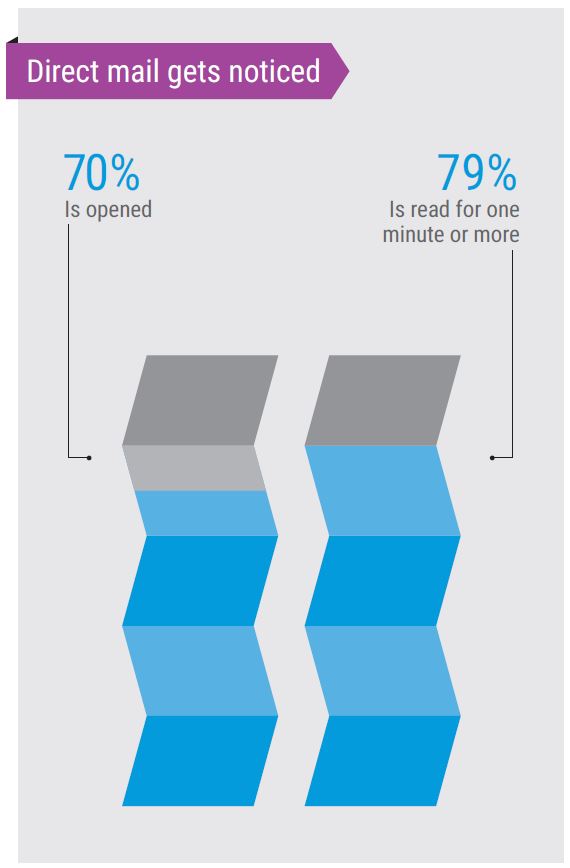I watched an interesting television commercial today.
A marketing firm was promoting its television, social media, and mobile marketing services by bashing direct mail. Why drain your marketing budget on direct mail campaigns that nobody reads? Contact your customers (especially business customers, which were the focus of the commercial) using the channels they prefer—television, social media, and mobile.
Obviously, this marketing firm hasn’t kept up with the data. Sure, social media and mobile marketing are on the rise. But that doesn’t mean that customers aren’t responding to direct mail or that this channel is losing its effectiveness in the B2B market (or in the B2C market either). It’s a false contrast.
Your customers are faced with these false contrasts all the time. Day in and day out, they are bombarded with false messaging that direct mail is dead. The reality is, direct mail remains a critical part of the mix. Here are some points to keep in front of them.
1. Direct mail doesn’t require opt-in.

You don’t have to get recipient’s permission to send direct mail. Unlike email and text messaging, people don’t have to opt in. This means that, even if a customer does not subscribe or unsubscribes from your email list, you can still reach them with direct mail. (This is a great reason to make sure you always get physical addresses from those on your email lists!)
2. Direct mail doesn’t get caught in the spam filter.
“Yes, it may be skimmed by a gate keeper,” notes Roger Buck, former director of marketing/new product development for The Flesh Company, responding to an invitation to comment on this subject on my LinkedIn page. “However, the odds are still much better — and it doesn’t contain a virus.”
3. Direct mail remains effective long after it hits the desk.

Think of it as the equivalent to consumers taping things to their refrigerator. “We’ve had people tell us that they had one of our mailings sitting on their desks for months,” notes Andre Palko, president of Technifold USA, adding his voice to the comments. “Although they didn’t act immediately, we remained top of mind until they were ready to act. You don’t get that kind of staying power—or attention—with email.”
4. It is still effective even when the target recipient has moved on from the company.
If you send an email to someone who’s no longer there, it bounces. If you send a postcard, the new person in that job sees it—and you’ve just introduced yourself as a vendor,” says Palko.
5. Direct mail doesn’t have the competition.
Email is an effective tool, but we are overwhelmed by it. This is true of consumers, but even more of businesses. In 2014, The Radicati Group found that business users sent or received 121 emails per day. By 2018, this is expected to rise to 141.
Larry Bradley, owner of Proforma Sunbelt Graphics, writes, “The overwhelming volume of email received at work is a huge hurdle for legitimate email marketers. It’s hard to separate the junk from the legitimate email. As a result, a huge percentage of email sent to businesses is never read. Businesses don’t receive nearly as much marketing mail as they did a decade ago. That’s a unique benefit for direct mailers.”
6. Certain offers just won’t get traction by email.
There is a reason businesses are more likely to get lending offers in the mail than they are by email. B2B decision-makers trust direct mail more than email, especially for high value products and services. Mailers can also include a wide variety of trust-building content not possible (or reasonable) to include in email. Yes, you can provide links, but with direct mail, you get that content in front of them in a tangible way right out of the gate.
7. Direct mail can reach high-level decision-makers that email can’t.

There are only so many things you can do to make email look more important, but beyond writing a compelling subject line, most of them look hokey. Direct mail offers options like kits, dimensional mail, and unique packaging options that, by their nature, get past the gatekeepers. (Palko has used everything from metallic envelopes, lunch bags, packing list pouches, and prescription bottles to mail letters. “They are not only fun, but they get opened!” he says.) While these mailings may have higher price tags, they can also get near 100% open rates. When you’re trying to reach the C-Suite, what’s that worth?
8. Direct mail drives social media and online marketing.
I go back to the television commercial I watched. The claim was that you don’t need direct mail because you have social media and mobile marketing. What was
overlooked is how those social media and mobile marketing relationships get captured in the first place. Very often, that’s print! Saying that you only need social and mobile but not print is akin to saying that when buying a house you only need the upper stories but not the foundation. Without print, getting those social and mobile engagements would be much more difficult.
Don’t let digital marketers get away with stealing your customers based on false contrasts. Open the discussion about the benefits of direct mail versus email, and when to use each. Be proactive. Don’t give digital-only marketers an unprotected flank.




Thanks for sharing. I would add one more point: Printed direct mail does not have malware and hacks 🙂
[…] (From the editor: This article was originally published on Digital Printing Hotspot.) […]